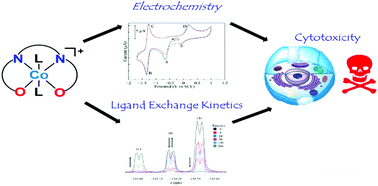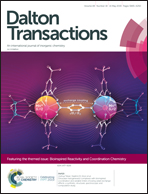Physical properties, ligand substitution reactions, and biological activity of Co(iii)-Schiff base complexes†
Abstract
Four cobalt(III) complexes of the general formula [Co(Schiff base)(L)2]+, where L is ammonia (NH3) or 3-fluorobenzylamine (3F-BnNH2), were synthesized. The complexes were characterized by NMR spectroscopy, mass spectrometry, and X-ray crystallography. Their electrochemical properties, ligand substitution mechanisms, and ligand exchange rates in aqueous buffer were investigated. These physical properties were correlated to the cellular uptake and anticancer activities of the complexes. The complexes undergo sequential, dissociative ligand substitution, with the exchange rates depending heavily on the axial ligands. Eyring analyses revealed that the relative ligand exchange rates were largely impacted by differences in the entropy, rather than enthalpy, of activation for the complexes. Performing the substitution reactions in the presence of ascorbate led to a change in the reaction profile and kinetics, but no change in the final product. The cytotoxic activity of the complexes correlates with both the ligand exchange rate and reduction potential, with the more easily reduced and rapidly substituted complexes showing higher toxicity. These relationships may be valuable for the rational design of Co(III) complexes as anticancer or antiviral prodrugs.

- This article is part of the themed collection: Bioinspired reactivity and coordination chemistry


 Please wait while we load your content...
Please wait while we load your content...
